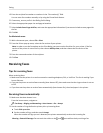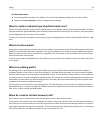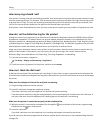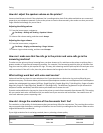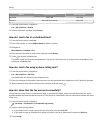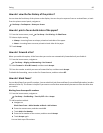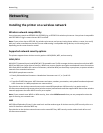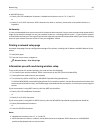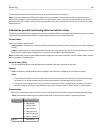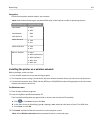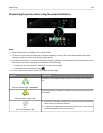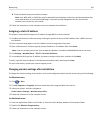
Networking
Installing the printer on a wireless network
Wireless network compatibility
Your printer may contain an IEEE 802.11b, IEEE 802.11g, or IEEE 802.11n wireless print server. Your printer is compatible
with IEEE 802.11 b/g/n routers that are Wi-Fi certified.
Note: If your printer has an IEEE 802.11g wireless print server and you are having issues with an n router, then verify
with your router manufacturer that the current mode setting is compatible with g devices, as this setting varies
depending on the router brand or model.
Supported network security options
The printer supports three wireless security options: WPA2/WPA, WEP, and no security.
WPA2/WPA
WPA (Wi-Fi Protected Access) and WPA2 (Wi-Fi Protected Access 2) offer stronger wireless network security than WEP.
WPA2 and WPA are similar types of security. WPA2 uses a more complex encryption method and is more secure than
WPA. Both WPA2 and WPA use a series of characters, called the WPA pre‑shared key or passphrase, to protect wireless
networks from unauthorized access.
WPA2/WPA passphrases must be:
•
Exactly 64 hexadecimal characters. Hexadecimal characters are A–F, a–f, and 0–9.
or
•
From 8 to 63 ASCII characters. ASCII characters are letters, numbers, punctuation, and symbols found on a keyboard.
ASCII characters in a WPA passphrase are case-sensitive.
Every device on the wireless network must use the same WPA passphrase. WPA security is an option only on
infrastructure networks with access points (wireless routers) and network cards that support WPA. Most newer wireless
network equipment also offer WPA2 security as an option.
Note:
If your network uses WPA2 or WPA security, then select WPA Personal when you are prompted to select the
type of security your network uses.
WEP
WEP (Wired Equivalent Privacy) is the most basic and the weakest type of wireless security. WEP security relies on a
series of characters called the WEP key.
Every device on the wireless network must use the same WEP key. WEP security can be used on both ad hoc and
infrastructure networks.
Networking 98



